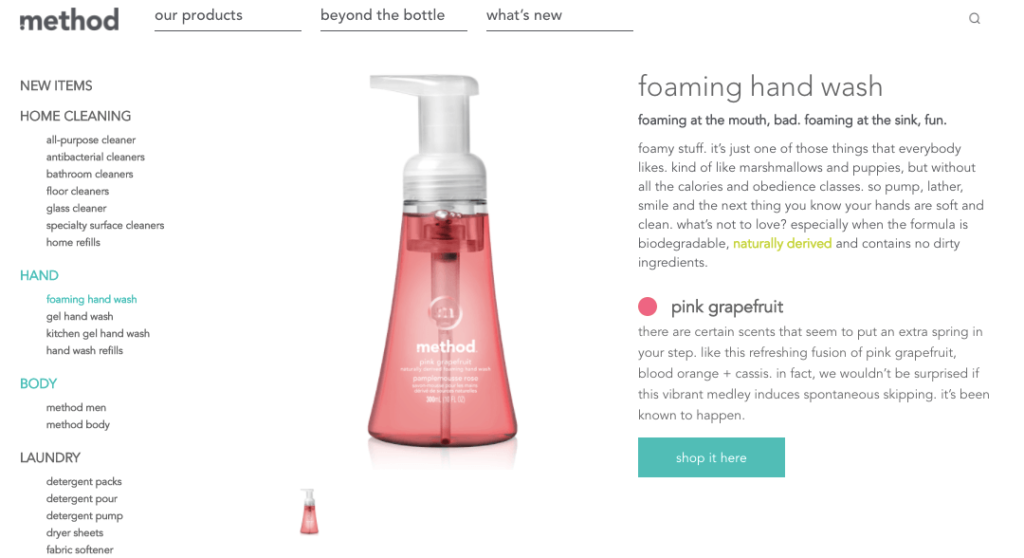At the risk of sounding a little dramatic, the Black Friday we know is no longer. New shopping habits and events in the world have altered many aspects of everyday life—including how we shop.
As a result, the way small businesses prepare for (and endure) the holiday shopping season will look much different. To see success this year, you must be ready from an eCommerce perspective.
We’re sharing several eCommerce tips for Black Friday that small businesses can leverage to make the most of the evolving holiday shopping season.
Here’s what we’ll look at in this post—skip ahead if you’d like:
- Black Friday in 2020: What you need to know
- eCommerce tips for Black Friday
- 1. Prepare your website for a surge in traffic
- 2. Embrace omnichannel selling
- 3. Plan your inventory strategy as early as possible
- 4. Prep your fulfillment team
- 5. Provide excellent customer support
- 6. Retarget people who’ve previously checked you out
- 7. Create eye-catching email marketing campaigns
Black Friday in 2020: What you need to know
This year has been challenging for retailers of all sizes and industries. Despite the remaining uncertainty of the coming weeks, here are a few things we know for sure about Black Friday in 2020.
Extended holiday shopping season
As you’ve likely seen, many retailers have already begun offering doorbuster deals. Rather than focusing on two days of in-store and Cyber Monday sales, retailers are spreading their Black Friday deals over the entire holiday season.
And with Amazon’s Prime Day, which happened this past October rather than in the summer, marking the unofficial kickoff of the holiday shopping season, this year will be a marathon, not a sprint.
What small businesses can do: Space your holiday offerings out as much as possible. That way, you aren’t relying on a single day that will be altered due to social distancing to drive revenue.
A different kind of in-store shopping experience
The logistics of in-store shopping has changed. Thanks to online shopping, we can say “goodbye” to crowds of people fighting over the last smart TV or balsam fir candle.
Social distancing measures will not only reduce the number of people in-store at a time, but this could mean a change in the number of people who shop in-store altogether.
What small businesses can do: Many big retailers like Best Buy, West Elm, and Williams-Sonoma have shifted to an appointment-only shopping experience to ensure stores don’t exceed capacity. Small businesses could take a similar approach.
An emphasis on eCommerce
With the drive to eCommerce, retailers should prepare for an influx in website traffic.
Small businesses must ensure their online storefront can not only handle additional website traffic but that customers have an excellent online shopping experience. We’ll touch more on this later in the article.
What small businesses can do: Take a look at your current website. Is it ready for the holiday shopping season? If not, it’s essential to make the necessary updates so you are ready to hit the ground running as soon as possible.
eCommerce tips for Black Friday
The holiday shopping season is a significant time of year for small businesses in particular. With so much to navigate—especially with the pandemic—it can feel overwhelming to keep business afloat.
Here are some of the best eCommerce tips that Black Friday small businesses can implement to make the most of this wild season.
1. Prepare your website for a surge in traffic
Your website will be the workhorse of your holiday shopping experience. As so many customers turn to online shopping this season, ensuring your website can accommodate a surge in traffic is vital.
To do this, be sure to test your website regularly to catch any glitches or potential issues. Keep your website updated and that you use a website hosting package that can accommodate surges of traffic. If you aren’t sure if your website can withstand holiday shopping traffic spikes, reach out to your hosting provider or eCommerce platform provider to verify.
But there’s more to a website than making sure it can handle an increase in website traffic. Focusing on creating a superb shopping experience for your customers—no matter the device they’re on—will set you apart from the competition.
There are other eCommerce elements to consider, such as:
Checkout process
A simple checkout experience can mean the difference between a customer going through with a purchase and navigating to a competitor. A study from Baymard found that 21% of shoppers will abandon a cart due to a complicated checkout process.1
When assessing your checkout process, consider these questions:
- Does your checkout process make sense to users?
- Are customers able to see how much they’ve saved or how much they’re going to pay for shipping?
- Is your checkout process secure?
For example, the athletic clothing line, Outdoor Voices, has an excellent checkout process that leaves nothing to the imagination:
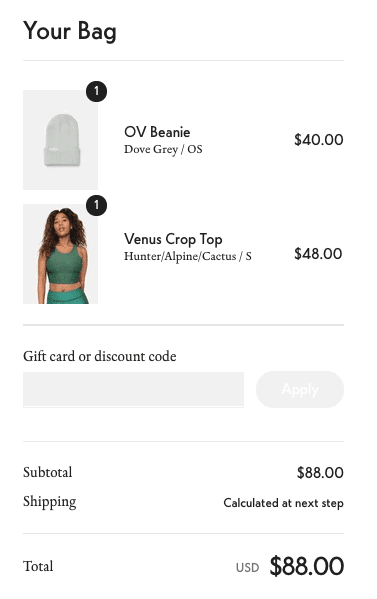
Customers know what they’re purchasing and how much each item costs. Outdoor Voices also provides information like how much customers save with a discount code and shipping costs.
Shipping and tracking notifications
Big box retailers have set a precedent for speedy shipping at little to no cost to customers. As a result, quick deliveries have become an industry expectation.
Shipping and tracking notifications not only help customers keep track of their orders, but they foster a sense of excitement. After all, who doesn’t love seeing their package marked as “Out for delivery”?
Shopify’s Shop app makes it easy for customers to manage their orders all from one place. Customers can add tracking numbers from various mail carriers and see where their orders are on the map:
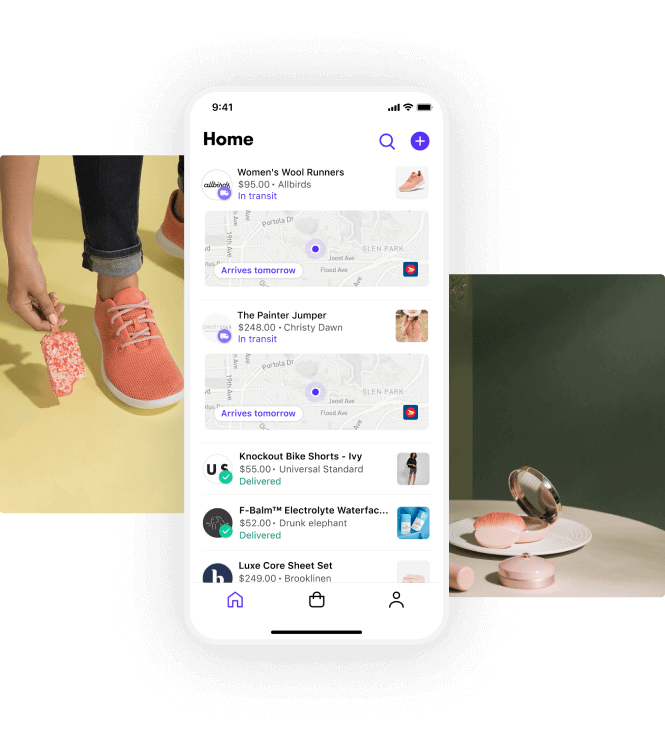
This is especially helpful if customers are ordering several things at once—which is safe to assume during the holidays!
Online product catalog
Did you know that 53% of shoppers research before purchasing a product?2 What’s more, 75% of eCommerce shoppers say product images are very influential when determining whether or not they want to buy a product.3
In other words, customers do their due diligence. They like to know they’re getting the best product that suits their needs (at the best price, mind you).
Why does this matter to small businesses? If customers are researching, it’s all the more critical to give them the information they need to decide. Or, more importantly, to show them that your product or service is the one they should purchase.
Product pages with clear photos, detailed descriptions, and other information like size charts, model sizes, materials, etc. play a huge role in getting customers to convert. Make this a priority.
An excellent example of standout product pages comes from Method:
Not only are Method’s product descriptions hilarious (and very on brand), but they also take them a step further by providing a list of ingredients so that folks who are concerned about what chemicals go onto their body can put their minds at ease:

2. Embrace omnichannel selling
When it comes to marketing channels for your eCommerce business, the more, the merrier—if those channels are high-performing, that is.
If you’ve embraced selling across various channels, like Instagram, Facebook, and Pinterest, the 2020 holiday season is an excellent time to invest in the channels that work best for you.
But, here’s the catch: Take a hard look at the channels that are worth the investment. For example, if your business moves a lot of products via Instagram, focus your efforts there.
It’s worth noting that the holidays might not be the best time to experiment with a new channel you’ve never tried selling on before. Stick to what’s been working.
Although you may be focusing your outreach efforts on a few strategic channels, your customers may be trying to contact you using multiple means of communication. This is especially true during the holiday shopping season where customers may be more inclined to contact customer support. To make this easier, consider implementing a customer service tool that supports omnichannel communication.
For example, a tool like RingCentral Engage Digital™ lets your team manage customer responses and questions on various channels like Facebook, Instagram, Twitter, and WhatsApp all from one dashboard. Here’s how it looks:
To make things even easier, AI technology analyzes each customer message and sends it to the right support agent. This way, your customers are getting the best help from the best person, every time. Whether it’s a phone call or email or social media message, all of these conversations get consolidated in one place:
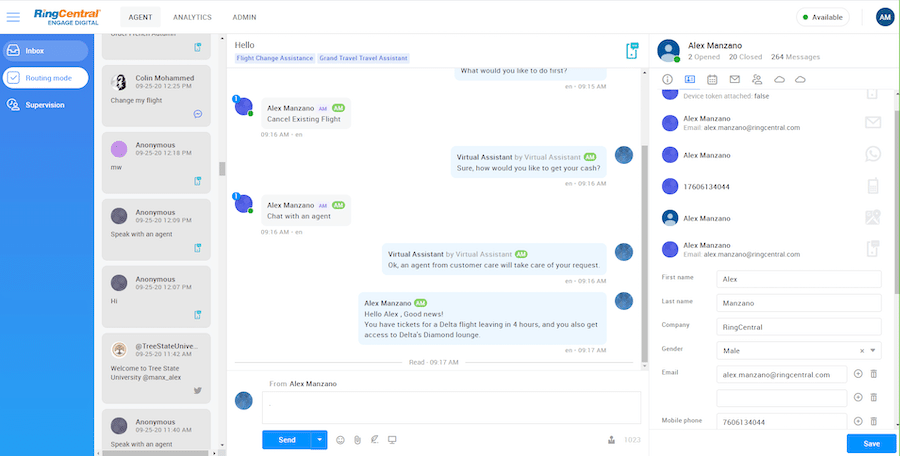
3. Plan your inventory strategy as early as possible
By now, you should have a solid idea of which products you plan on selling during the holidays. Plus, as shipping and stocking procedures have shifted (read: slowed) thanks to events like COVID-19, getting a good grasp on your inventory should be a priority.
If you aren’t sure which products to choose, there are multiple ways to approach it.
First, many eCommerce platforms include analytics that let you see which products have been flying off your shelves. Keep in mind there may be products that sell well all year round and products that sell well during the holidays.
If you want additional insight, consider running an ABC analysis on your inventory.4 An ABC analysis breaks your inventory into three categories (A, B, and C), or your best, middle, and worst performing products.
Let’s take a look at each category in more detail:
- A products: Products in this category are your top-tier products. They account for roughly 80% of your revenue.
- B products: These products are lukewarm for your business. B products make up 15% of your revenue.
- C products: C products are your least performing products—or the ones that rarely sell. These products account for 5% of your total revenue.
So, what can small business owners do with this information?
Focus on your A products first and foremost. It’s essential to have an adequate amount of A product inventory, perhaps even a surplus.
However, it’s equally as important to have B products in stock as well. Typically, B products swing between A products and C products, so there’s potential for them to move up in your product rankings.
Even though C products don’t make you a ton of money, they still generate something! Therefore, it’s smart to invest in some C products. They may be slow-to-sell for your business, but they still carry some weight.
4. Prep your fulfillment team
You don’t want to wait until the last minute to have your holiday fulfillment logistics sorted out. A well-oiled fulfillment machine, especially during this time of year, has a significant impact on how quickly and seamlessly you can get orders to customers.
So, where do you begin?
There are four actions you can take to make a successful fulfillment team:
- Hire extra staff
- Establish an order prioritization process
- Keep your stock room organized
- Build a communication plan
Let’s take a look at each in more detail.
Hire extra staff
It’s all hands on deck during the holiday shopping season. Additional orders warrant additional hands, eyes, and brains to make sure the process is smooth from when an order is placed until it ships.
It’s important to consider where you need additional support. This will help you determine how many employees to hire, what skill sets you’re looking for in employees, and how to divide responsibilities.
Look for employees who have experience in fulfillment as well as other skills like customer service.
Establish an order prioritization process
As a small business owner, you want to process and ship orders as fast as possible to make your customers happy. But the reality is that some orders may need to be shipped sooner than others.
Creating an order prioritization system eliminates potential issues like late shipping, lost packages, and wrong orders. For example, if you offer expedited shipping, you’ll want to make sure those orders are processed and shipped first.
Or, you could also prioritize by product type. If you have perishable products, those will likely need to be shipped as soon as possible.
No matter how you choose to prioritize, it’s best to consider all angles.
Keep in mind that with big events and holidays, shipping has become a challenge for many small businesses due to delays. Therefore, it’s crucial to stay updated on the policies of different carriers.
Keep your stock room organized
There’s no faster way to stress yourself out during this season than to work in a chaotic stock room. As your team starts to process orders, emphasize the importance of keeping things neat and organized.
This way, everything is where it needs to be, and nothing gets overlooked. If this has been a problem for you in the past, consider hiring a stock room manager to keep tabs on things.
Build a communication plan
Like an unorganized stock room, a fulfillment team that isn’t aligned when communicating is a recipe for disaster. Create a communication plan that’s easy for your team to learn and use.
How do you like to communicate with your teammates, prospects, clients, and customers?
If you’re like most businesses, you’re probably using any variety of messaging, video conferencing, and good ol’ phone calls to keep in touch with all these people. And like many businesses, you might be using multiple apps or tools to handle all these channels.
Did you know you could be using just one app instead?
For example, there are all-in-one communication solutions (like RingCentral!) that give you exactly those options—messaging, video conferencing, a phone service, and more—all in one app:
5. Provide excellent customer support
No matter if you’re a team of five or a team of 50, offering additional customer service support during the holidays is vital. In fact, customer service queries increase by 75% around the holidays.5 What’s more, 47% of customers expect fast replies during this time as well.
The rules of customer services have shifted over the years. That said, it’s safe to say that boosting your customer service support will be essential.
There are a few things to keep in mind when thinking about additional customer support over the holidays:
- Focus on personalization: Every customer interaction is essential. Facetime with your customers allows you to make their experience with your business that much more special. Adding a touch of personalization to these interactions—whether it’s recommending new products or using their name in conversation—goes a long way.
- Add an element of delight: The holidays can be stressful for everyone. Going out of your way to make your customer smile can leave a lasting impression. A few ideas include surprising them with a gift card or a discount or upgrading their shipping method for free.
But to make this level of support possible, your team needs the right tools. Whether it’s a social CRM or customer service software, there’s an option out there that can probably make your life (and your team’s lives) easier.
🕹️ Get a hands-on look at how RingCentral can help you get more done (and get more customers) on Black Friday by booking a product tour:
💰 You can also use this calculator to see roughly how much your business could save by using RingCentral to support your team’s communication with each other—and clients.
6. Retarget people who’ve previously checked you out
Retargeting may be a more advanced marketing tactic, but if used correctly, it’s super powerful.6 The goal of retargeting is to get your brand back in front of people who have visited your website or interacted with you on social media somehow.
For the most part, retargeting involves targeting those potential customers with paid ads—both on social media channels and through display ads.
So how does it work?
The possibilities are endless with retargeting, which is one of the best parts of it. But that can also feel overwhelming.
Here’s how to get started with retargeting:
- Define your goal: What are you trying to accomplish with retargeting? Re-engage previous visitors or website traffic? Encourage almost-customers who abandoned their carts to purchase? Whatever you choose, make sure your goal is clear. Your goal will dictate the channel you decide to use for your campaign(s).
- Identify your target customers: You have your goal in place, but now you must determine who you’re retargeting. Creating audience segments will help you set up your campaigns in a snap. For example, you could build audience segments per product, per channel, or per action (e.g., customers who abandoned their carts).
- Keep testing: As with all paid ad campaigns, it’s important to continue testing. Take note of which campaigns are performing the best and why that might be. Every adjustment you make will get you closer to a high-performing campaign.
7. Create eye-catching email marketing campaigns
Is it the holiday shopping season without an email campaign? There’s a reason why email is such a successful channel for small businesses, and one of the best eCommerce tips for Black Friday.
But with roughly 116.5 million emails sent on Black Friday, and 106 million emails sent on Cyber Monday, how can small businesses stand out from the crowd?7
Before we dive into email marketing best practices, let’s rewind for a minute. Why is email such an important marketing tool, particularly around the holidays?
- Reach customers in creative ways: Email lets you market directly to your customers in unique ways. Several email marketing platforms allow brands to let their creativity (and brand) shine.
- Optimize for mobile from the start: Email is built for the mobile experience. And with more people shopping on their phones, which will likely increase due to the pandemic, it’s critical to reach customers on the channels they use.
- Automation capabilities: You’re busy. There’s no doubt about that. Instead, you can automate your email campaigns, so you don’t have to think twice about whether your Black Friday drip campaign went live.
Now, let’s take a look at two stellar examples of holiday email campaigns.
Madewell: Shop Cyber Monday early
As we mentioned above, several brands offer sales across multiple days rather than strictly on Black Friday or Cyber Monday. This email from Madewell is simple, yet it piques their audience’s interest. After all, who wouldn’t want to shop their favorite brands sales early?

Not only does Madewell use enticing language like “Cyber Monday Preview,” in addition to an eye-catching subject line, “Hey wanna shop Cyber Monday early?” but they include many product shots to encourage shopping.
Notes for small business owners: Focus on showcasing your products, especially your best-sellers, throughout your holiday emails. Offering early access to an exclusive list, like your email subscribers or loyal customers, is a great way to ramp up spending.
Fabletics: Exclusive access to Black Friday
Fabletics has also been offering early access to select products. Their approach is a bit different from Madewell:
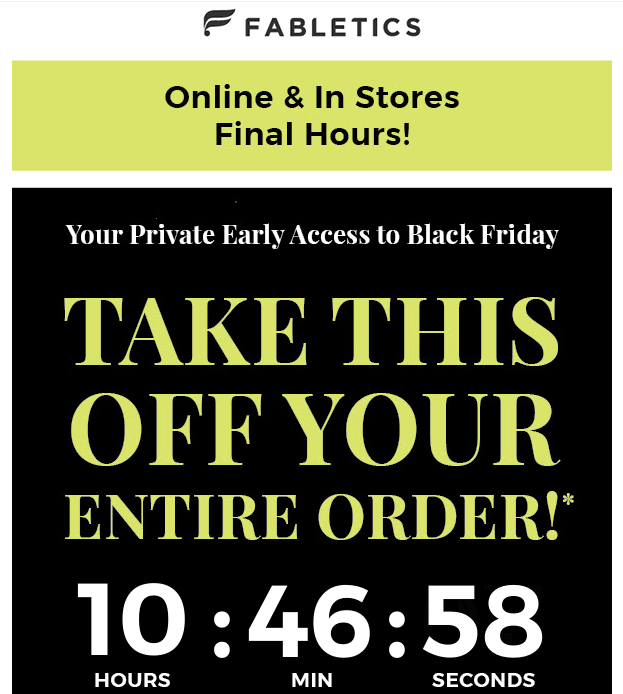
Their use of bold colors and a countdown clock create a sense of urgency for customers. Rather than showcasing their products in the email, the athletic clothing brand wants customers to click to the site to start shopping.
Prepare for an atypical holiday shopping season
Planning for the holiday shopping season is challenging under non-pandemic circumstances. We hope these eCommerce tips for Black Friday help you navigate these uncertain times and give you confidence in making the most of this season.
Remember, you’re a small business. You’re scrappy and built to withstand the storm—and you’ve got an edge this Black Friday.
1baymard.com/lists/cart-abandonment-rate
2thinkwithgoogle.com/consumer-insights/consumer-trends/shopping-research-before-purchase-statistics
3weebly.com/inspiration/online-store-product-photography
4help.shopify.com/en/manual/products/inventory/abc-analysis
5freshdesk.com/customer-support/holiday-season-blog
6adroll.com/blog/marketing/6-tips-on-how-to-launch-a-successful-retargeting-campaign
7campaignmonitor.com/resources/infographics/holiday-email-marketing-by-the-numbers
Originally published Nov 16, 2020, updated Jan 30, 2023


